Author: Berry Matijssen
Reading time: 8m:47s
Updated: 3 June 2024
Looking back at the Eurovision Song Contest 2024
The initial goal of this article was to review my earlier prediction for the Eurovision Song Contest 2024. However, with my predicted winner, the Netherlands being disqualified and my not-so favourite Switzerland winning, my prediction was completely off.
There were a few things that I missed. Most importantly, my prediction for the jury vote was not taken enough into account, but the televote seems to match the outcome. Surprisingly, as I looked more into the final result, it appears that the organiser EBU also has a few tricks to influence the outcome. Mainly by placing competing countries next to each other would reduce their points, while placing it next to a poor performer would increase their points. This article will explain more about the mechanisms that drive the outcome of the Eurovision Song Contest.
The myth of the death spot in the first half of the program
One of the common myths in Eurovision is the importance of the order of the performances in the final. It is believed that the first half is unlikely to provide the winner, while the second half will improve the chance of being the winner. The suggested reason behind this belief is that the audience is more likely to remember the later participants. This would happen during the live performance, but also when the summary of all songs is played while the voting goes on. A quick dive into the numbers can validate if this assumption is true or not.
When ranking the countries in order of appearance in the final and comparing this to the jury and televote, an obvious pattern is revealed. To illustrate this, the best five songs are coloured green, the next 10 orange and the 10 worst performers red. This shows there are several high performing songs in the first and in the second half. However, it is clear that the most politically motivated countries (Ukraine and Israel) are in the first half, while three other potential candidates (Switzerland, Croatia and France) are in the last six spots. Remarkably, it is clearly visible that in the last spots, there is an enormous contrast between songs that perform excellent or do very worse.
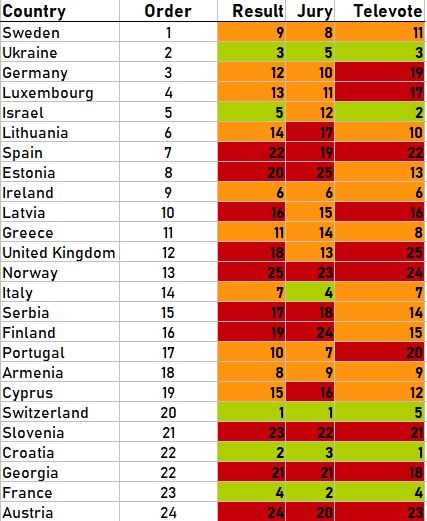
Figure 1: Results of the Eurovision 2024 including the jury and televote. Green indicates the top 5 best performing countries, orange the next 10 and red the 10 worst performers. Note that the last part shows the best and worst performing countries directly next to each other.
This leads to my conclusion of the ranking. The order of appearance in itself is not so important for the final outcome. However, there is an indication that the organiser puts its focus on the best candidates in the last session, meaning that the second half being more successful is the result of conscious programming. To make them stand out even more, they put very poor candidates next to them. Because the semi-finals have already occurred, it is largely known to the organization how the public will vote.
For those who like conspiracy theories, this opens the door for the organisers to cheat on the outcome. If you want to give out a message to the juries who to give points and who not, just put the undesired in the first of the show and the suggested winners at the end. To enhance this effect, the desired winner is surrounded on both sides with poorly performing countries and votes could be shifted in the direction of the winner.
The importance of unity in voting
The final score consists of two parts: the jury and the televote. The idea behind this is that a professional jury is independent and rates a participant based on the song and performance, while the audience votes based on what appeals to them. This way of voting was introduced to remove the influence of politics, migration and neighbour loving from the Eurovision. By visualizing the jury and televote by colouring the 10 and 12 points green and the other points orange, a clear insight into the voting system can be obtained.
The jury vote is remarkably similar to each other when it comes to the winner. Almost every country gave 10 or 12 points to Switzerland. For the other countries, there is a large diversity of the number of points they got. The result is an overwhelming support for Switzerland with 365 points, while the runners-up France (218 points) and Croatia (210 points) got significantly less. It is also clear that these juries are not completely independent. Croatia (as the only country to do so) gave no points to Switzerland, while receiving eight points in reverse.
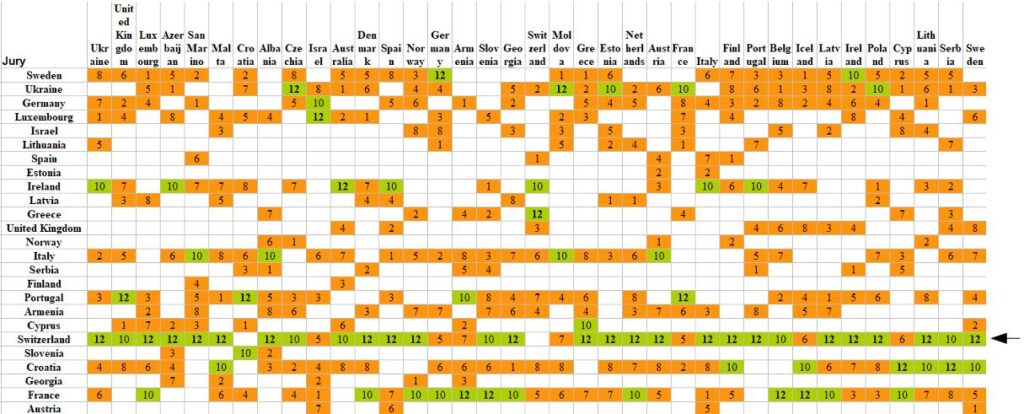
Figure 2: Results of the jury vote. Green indicates the 10 and 12 points. The arrow indicates the one country that got the majority of votes from the jury.
The televote shows much a more dispersed picture. There are three countries (Ukraine, Israel and Croatia) receiving many high points (10 or 12). This makes it automatically that points are more divided. These countries are also much more tied to each other with Croatia receiving 337 points, Israel 323 points and Ukraine 307 points.
There is little denying the influence of politics on the televote. Both Ukraine and Israel are involved in military conflicts. But it appears that Croatia is the ‘honest’ most liked by the public.
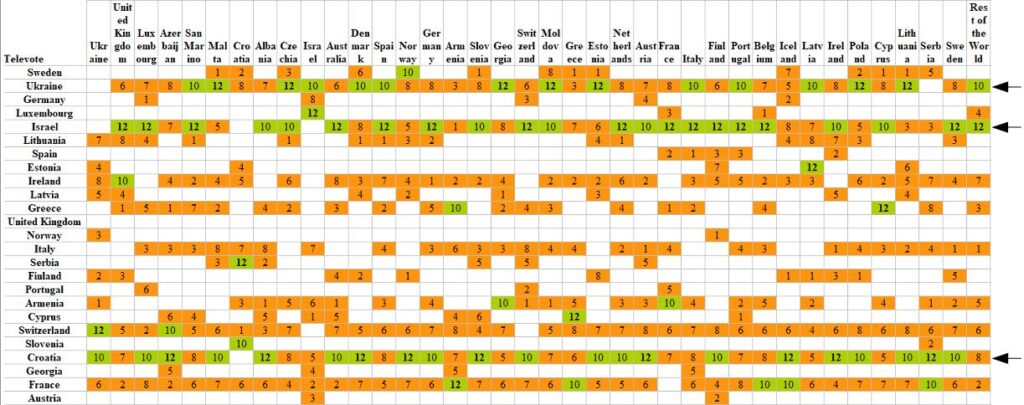
Figure 3: Results of the jury vote. Green indicates the 10 and 12 points. The arrows indicates the three countries that got the majority of votes by the public.
By introducing a jury vote, the Eurovision Song Contest intended to remove undesired influences, and introduce a more professional and objective touch to it. It can be argued that they have changed the Eurovision into a jury score only. Because of the differences in countries and their relationship between them (good or bad), it makes the televote much more diverse than the jury score. In essence, if the jury would jointly decide on a winner, the public would have to all stand behind an alternative winner to prevent it from happening.
Most noticeable in the outcome is that the televote has a set of favourites, while the jury only has one. Because all juries are professional and expected to use the same judging criteria a more clear view on the top 5 best performes would be expected, not this dispersed view of assigned points.
The suspicious activities of Israel
The outcome of Israel in the Eurovision was good, with a fifth place and 375 points. It should be noted that 323 points came from the televoting which is 86%. This is kind of remarkable because there was a lot of discussion about their participation. The result of this was very noticeable boo-ing during their performance.
There is an indication that Israel has some sort of activism going on to promote a win, which is backed up by the leaking of the voting of Italy in the semi-final. This showed that 39% voted for Israel and the second best was the Netherlands with 7%. The 2021 final which voted in favour of Ukraine showed 29%. An early finding by StoCoTo.com showed that the like-ratio for the YouTube video was much higher compared to other participating countries.
The mechanism for this outcome was provided by the Irish TV station RTE. Basically, when you get all your supporters to vote, you have a larger voting group than all others as they tend to spread their votes. In addition, when there is controversy and as a result, the total number of people who vote is lower, but when for one group this does not change, they gain even more. In other words, it is well possible that all who voted for Israel did so, but many others didn’t vote at all because of the ongoing controversy.
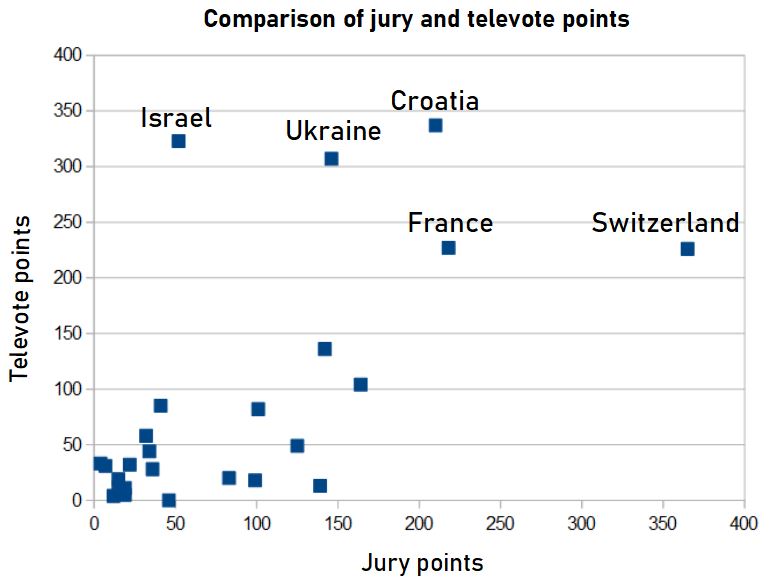
Figure 4: Comparison of the points given by the jury and the televote. The best ones are highlighted. Note that Israel and Switzerland are on opposite ends.
Some insights into the performance of the Netherlands
My original prediction was that the Netherlands would win. Part of my prediction turned out to be correct as soon as the voting results of the semi-final were made public. But the reality is that Switzerland has won due to an overwhelming jury vote, which my analysis did not take into account.
There is little doubt about the popularity of the contestant of the Netherlands, Joost Klein with the song Europapa. In the semi-finals they obtained 182 points, which made them second after Israel. Compare this to the other semi-final which shows Croatia a win with 177 points, there is no doubt that the Dutch song is incredibly popular with the broad audience and was a strong contender to win the televote.
The placement next to Israel is not a coincidence, but a conscious decision made by the organiser, the so-called ‘producer choice’. Given that all other top-participants are nicely mixed with unpopular songs, this can be viewed as an indication that the organisers didn’t want any of these two songs to win. This strategy didn’t work because of the disqualification of the Netherlands and Israel received a massive 323 points from the televote. There is also little doubt that disqualifying one of the most popular songs influences the points giving to other countries by televote.
Was the win of Sweden in 2023 real or did it get some help?
In 2023 there was this theory that Sweden needed to win the Eurovision so it could be the organising country 50 years after ABBA won the Eurovision. It is fair to say that ABBA has been a very succesful and best-known winner of the Eurovision.
It is not possible to only artificially win the Eurovision. Having a good song and good artist is a requirement. The artist that Sweden sent was Loreen who won the Eurovision before in 2012. The song was in similar style to the 2012 edition. It goes beyond doubt that she is a great artist and that there was a significant effort to deliver a quality production of the music.
But based on the learnings presented earlier, it can be argued that the organisers helped as well. The two favourites from the Eurovision 2023 were Sweden and Finland. This was clear at the start of the final. Sweden won by the jury vote by a significant margin, with Sweden receiving 340 points and Finland only receiving 150 points. Even more, Sweden was in the final surrounded by countries that received very poor results in the jury vote but Finland came after two other countries that received equal scores from the jury. Both participants were surrounded by countries that have low scores in televoting. Given that the jury vote had only one real favourite for the jury vote, it is very hard for the public televote to beat the jury.
There was one unknown in the 2023 contest, and that was the role of Ukraine. The year before, it had literally overwhelmed the competition with the televote. This could happen again and remarkably Norway was put next to it to perform. The jury vote for Norway was low, making it a poor performer, but the televote was the third best. Having learned that having a poor act before and after you makes you stand out more, it could be argued that the strategy was to place a true popular act next to it to prevent it from getting too many points in the televote.
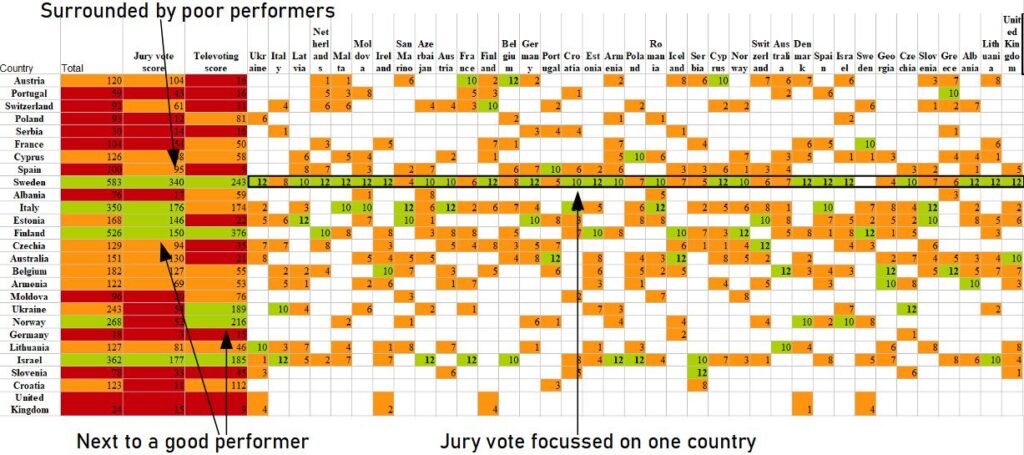
Figure 4: The results of the 2023 Eurovision with Sweden winning. Shown is the juryvote and the performance colours similar to other figures. Note the placement of Sweden surrounded by poorly performing countries and the focus of the jury vote consistently giving Sweden high points..
Conclusion on influencing the results of the Eurovision
For a song contest that does not allow politics to enter its arena, both the participating countries and organisation appear to be strongly involved in politics. There are several strategies for influencing the outcome of the Eurovision Song Contest.
For the participating countries, it is all about mobilizing the people who believe in your political cause. This will get you votes from people that support you and normally don’t vote, while at the same time deter other voters from taking part.
For the organisers there are three tools available:
- The jury can be influence the outcome by all standing behind one country while spreading points across all other participants.
- Putting their favourite country next to very poorly performing countries will boost their televote score
- Placing two competitors next to each other to steal points away from each other.
Scoring the songs in the Eurovision is always challenging as there is no objective manner such as measuring time or distance. This makes the system very prone to influences. With a jury or public voting, this is always going to be difficult. Maybe a data science approach by identifying underlying signals could be a solution for the future.
